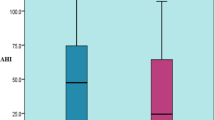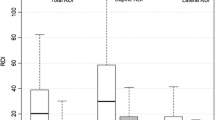Abstract
Purpose
Gender differences influence upper airway anatomy and physiology. The purpose of our study was to evaluate the influence of gender as well as anthropometric measures on severity of obstructive sleep apnea (OSA).
Methods
A retrospective review of patients referred to our sleep laboratory for evaluation of OSA was done. Patients with a diagnosis of OSA (Respiratory Disturbance Index (RDI) > 5) were included in the study. Anthropometric measurements were available for all the patients included in the study. Measurements of subjects’ height, weight, neck size, and waist and hip sizes were used in the study; waist–hip ratio and neck-to-height ratio were calculated.
Results
Three hundred eighty-six females and 661 males were included. Women were older than men and had a higher body mass index (BMI) and waist-to-hip ratio; men had a thicker neck circumference and a higher neck-to-height ratio. The severity of OSA was significantly higher in males (RDI 41.2 ± 27.9 in men vs. 30.0 ± 26.7 in women, p < 0.0001) despite a lower BMI and age in the men. Severity of OSA, as measured by RDI, varied significantly with changes in anthropometric measures such as neck circumference, and waist and hip sizes in both genders. Waist-to-hip ratio was associated with severity of OSA in men but not in women (p = 0.19 and 0.0001 in women and men, respectively). However, no single anthropometric value was found to be strongly predictive of OSA severity.
Conclusion
Despite having a higher mean BMI and age, women have lower RDI compared with men. Waist-to-hip ratio is more predictive of severity of OSA in men than in women. However, the correlation of anthropometric measures with severity of OSA was weak in our subjects.
Similar content being viewed by others
References
Chobanian AV, Bakris GL, Black HR, Cushman WC, Green LA, Izzo JL Jr, Jones DW, Materson BJ, Oparil S, Wright JT Jr, Roccella EJ (2003) The seventh report of the Joint National Committee on Prevention, Detection, Evaluation, and Treatment of High Blood Pressure: the JNC 7 report. JAMA 289(19):2560–2572
Wang H, Parker JD, Newton GE, Mak S, Chiu KL, Ruttanaumpawan P, Tomlinson G, Bradley TD (2007) Influence of obstructive sleep apnea on mortality in patients with heart failure. J Am Coll Cardiol 49(15):1625–1631
Shahar E, Whitney CW, Redline S, Norman RG, Dodge RR, Shahar E, Surovec S, Nieto FJ (2001) Sleep-disordered breathing and cardiovascular disease: cross-sectional results of the Sleep Heart Health Study. Am J Respir Crit Care Med 163(1):19–25
Sahlin C, Sandberg O, Gustafson YG, Bucht B, Carlberg H, Stenlund KA, Franklin (2008) Obstructive sleep apnea is a risk factor for death in patients with stroke: a 10-year follow-up. Arch Intern Med 168(3):297–301
Koehler U, Schafer H (1996) Is obstructive sleep apnea (OSA) a risk factor for myocardial infarction and cardiac arrhythmias in patients with coronary heart disease (CHD)? Sleep 19(4):283–286
Liston R, Deegan PC, McCreery C, McNicholas WT (1994) Role of respiratory sleep disorders in the pathogenesis of nocturnal angina and arrhythmias. Postgrad Med J 70(822):275–280
Shepard JW Jr (1992) Hypertension, cardiac arrhythmias, myocardial infarction, and stroke in relation to obstructive sleep apnea. Clin Chest Med 13(3):437–458
Young T, Finn L, Peppard PE, Szklo-Coxe M, Austin D, Nieto FJ, Stubbs R, Hla KM (2008) Sleep disordered breathing and mortality: eighteen-year follow-up of the Wisconsin Sleep Cohort. Sleep 31(8):1071–1078
Patel M, Tran D, Chakrabarti A, Vasquez A, Gilbert PE, Davidson TM (2008) Prevalence of snoring in college students. J Am Coll Health 57(1):45–52
Young T, Palta M, Dempsey J, Skatrud J (1993) The occurrence of sleep-disordered breathing among middle-aged adults. N Engl J Med 328(17):1230–1235
Bixler EO, Vgontzas AN, Ten Lin HM, Have T, Leiby BE, Vela-Bueno A, Kales A (2001) Prevalence of sleep-disordered breathing in women: effects of gender. Am J Respir Crit Care Med 163(3 Pt 1):608–613
Millman RP, Carlisle CC, McGarvey ST, Eveloff SE, Levinson PD (1995) Body fat distribution and sleep apnea severity in women. Chest 107(2):362–366
Guilleminault C, Quera-Salva MA, Partinen M, Jamieson A (1988) Women and the obstructive sleep apnea syndrome. Chest 93(1):104–109
Zhou XS, Shahabuddin S, Zahn BR, Bab-cock MA, Badr MS (2000) Effect of gender on the development of hypocapnic apnea/hypopnea during NREM sleep. J Appl Physiol 89(1):192–199
Popovic RM, White DP (1995) Influence of gender on waking genioglossal electromyogram and upper airway resistance. Am J Respir Crit Care Med 152(2):725–731
Lee JJ, Ramirez SG, Will MJ (1997) Gender and racial variations in cephalometric analysis. Otolaryngol Head Neck Surg 117(4):326–329
Schellenberg JB, Maislin G, Schwab RJ (2000) Physical findings and the risk for obstructive sleep apnea. The importance of oropharyngeal structures. Am J Respir Crit Care Med 162(2 Pt 1):740–748
Pillar G, Malhotra A, Fogel R, Beauregard J, Schnall R, White DP (2000) Airway mechanics and ventilation in response to resistive loading during sleep: influence of gender. Am J Respir Crit Care Med 162(5):1627–1632
Trinder J, Kay A, Kleiman J, Dunai J (1997) Gender differences in airway resistance during sleep. J Appl Physiol 83(6):1986–1997
Stradling JR, Crosby JH (1991) Predictors and prevalence of obstructive sleep apnoea and snoring in 1001 middle aged men. Thorax 46(2):85–90
O’Donnell CP, Schwartz AR, Smith PL (2000) Upper airway collapsibility: the importance of gender and adiposity. Am J Respir Crit Care Med 162(5):1606–1607
Shelton KE, Woodson H, Gay S, Suratt PM (1993) Pharyngeal fat in obstructive sleep apnea. Am Rev Respir Dis 148(2):462–466
Schwab RJ, Gupta KB, Gefter WB, Hoffman EA, Pack AI (1995) Upper airway and soft tissue anatomy in normal subjects and patients with sleep-disordered breathing. Significance of the lateral pharyngeal walls. Am J Respir Crit Care Med 152(5 Pt 1):1673–1689
Dancey DR, Hanly PJ, Soong C, Lee B, Hoffstein V (2003) Gender differences in sleep apnea: the role of neck circumference. Chest 123(5):1544–1550
Horner RL, Mohiaddin RH, Lowell DG, Shea SA, Burman ED, Longmore DB (1989) Sites and sizes of fat deposits around the pharynx in obese patients with obstructive sleep apnoea and weight matched controls. Eur Respir J 2(7):613–622
Rowley JA, Sanders CS, Zahn BR, Badr MS (2002) Gender differences in upper airway compliance during NREM sleep: role of neck circumference. J Appl Physiol 92(6):2535–41
Hoffstein V, Mateika S (1992) Differences in abdominal and neck circumferences in patients with and without obstructive sleep apnoea. Eur Respir J 5(4):377–381
Katz I, Stradling J, Slutsky AS, Zamel N, Hoffstein V (1990) Do patients with obstructive sleep apnea have thick necks? Am Rev Respir Dis 141(5 Pt 1):1228–1231
Whittle AT, Marshall I, Mortimore ILP, Wraith RS, Douglas N (1999) Neck soft tissue and fat distribution: comparison between normal men and women by magnetic resonance imaging. Thorax 54(4):323–328
White DP, Lombard RM, Cadieux RJ, Zwillich CW (1985) Pharyngeal resistance in normal humans: influence of gender, age, and obesity. J Appl Physiol 58(2):365–371
Rowley JA, Zhou X, Vergine I, Shkoukani MA, Badr MS (2001) Influence of gender on upper airway mechanics: upper airway resistance and Pcrit. J Appl Physiol 91(5):2248–2254
Kapsimalis F, Kryger MH (2002) Gender and obstructive sleep apnea syndrome, part 2: mechanisms. Sleep 25(5):499–506
Davidson TM, Patel MR (2008) Waist circumference and sleep disordered breathing. Laryngoscope 118(2):339–347
Simpson L, Mukherjee S, Cooper MN, Ward KL, Lee JD, Fedson AC, Potter J, Hillman DR, Eastwood P, Palmer LJ, Kirkness J (2010) Sex differences in the association of regional fat distribution with the severity of obstructive sleep apnea. Sleep 33(4):467–74
Martinez-Rivera C, Abad J, Fiz JA, Rios J, Morera J (2008) Usefulness of truncal obesity indices as predictive factors for obstructive sleep apnea syndrome. Obesity 16(1):113–8
Dancey DR, Hanly PJ, Soong C, Lee B, Hoffstein V (2001) Impact of menopause on the prevalence and severity of sleep apnea. Chest 120(1):151–155
Cakirer B, Hans MG, Graham G, Aylor J, Tishler PV, Redline S (2001) The relationship between craniofacial morphology and obstructive sleep apnea in whites and in African-Americans. Am J Respir Crit Care Med 163(4):947–950
Young T, Peppard PE, Gottlieb DJ (2002) Epidemiology of obstructive sleep apnea: a population health perspective. Am J Respir Crit Care Med 165(9):1217–1239
Vasu TS, Doghramji K, Cavallazzi R, Grewal R, Hirani A, Leiby B, Markov D, Reiter D, Kraft WK, Witkowski T (2010) Obstructive sleep apnea syndrome and postoperative complications: clinical use of the STOP-BANG questionnaire. Arch Otolaryngol Head Neck Surg 136(10):1020–1024
Subramanian S, Hesselbacher SE, Aguilar R, Surani SR. (2010) The NAMES assessment: a novel combined-modality screening tool for obstructive sleep apnea. Sleep Breath (E-pub)
Collop NA, Anderson WM, Boehlecke B, Claman D, Goldberg R, Gottlieb DJ, Hudgel D, Sateia M, Schwab R, Portable Monitoring Task Force of the American Academy of Sleep Medicine (2007) Portable Monitoring Task Force of the American Academy of Sleep Medicine Clinical guidelines for the use of unattended portable monitors in the diagnosis of obstructive sleep apnea in adult patients. J Clin Sleep Med 3(7):737–747
Author information
Authors and Affiliations
Corresponding author
Rights and permissions
About this article
Cite this article
Subramanian, S., Jayaraman, G., Majid, H. et al. Influence of gender and anthropometric measures on severity of obstructive sleep apnea. Sleep Breath 16, 1091–1095 (2012). https://doi.org/10.1007/s11325-011-0607-9
Received:
Revised:
Accepted:
Published:
Issue Date:
DOI: https://doi.org/10.1007/s11325-011-0607-9




